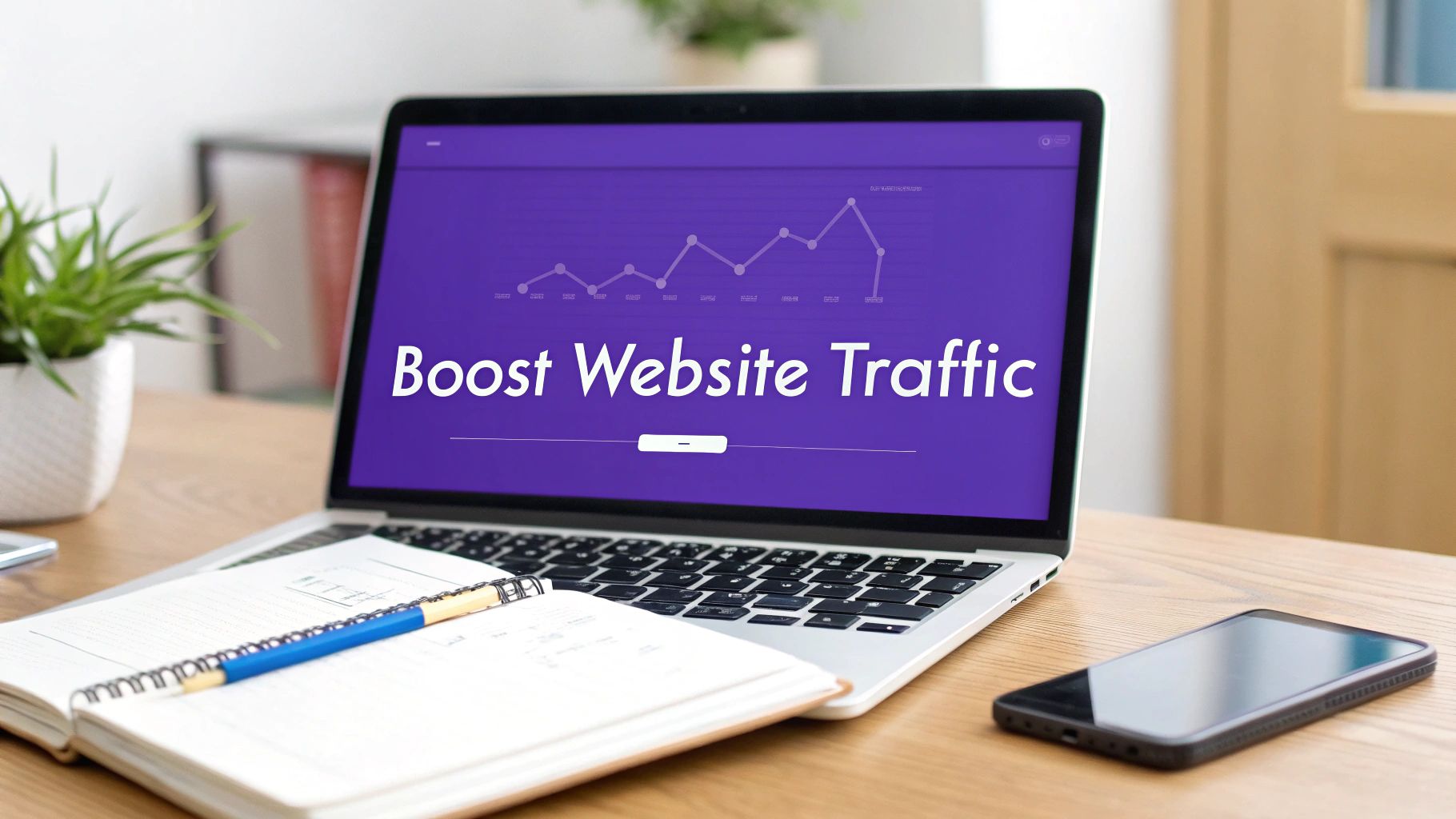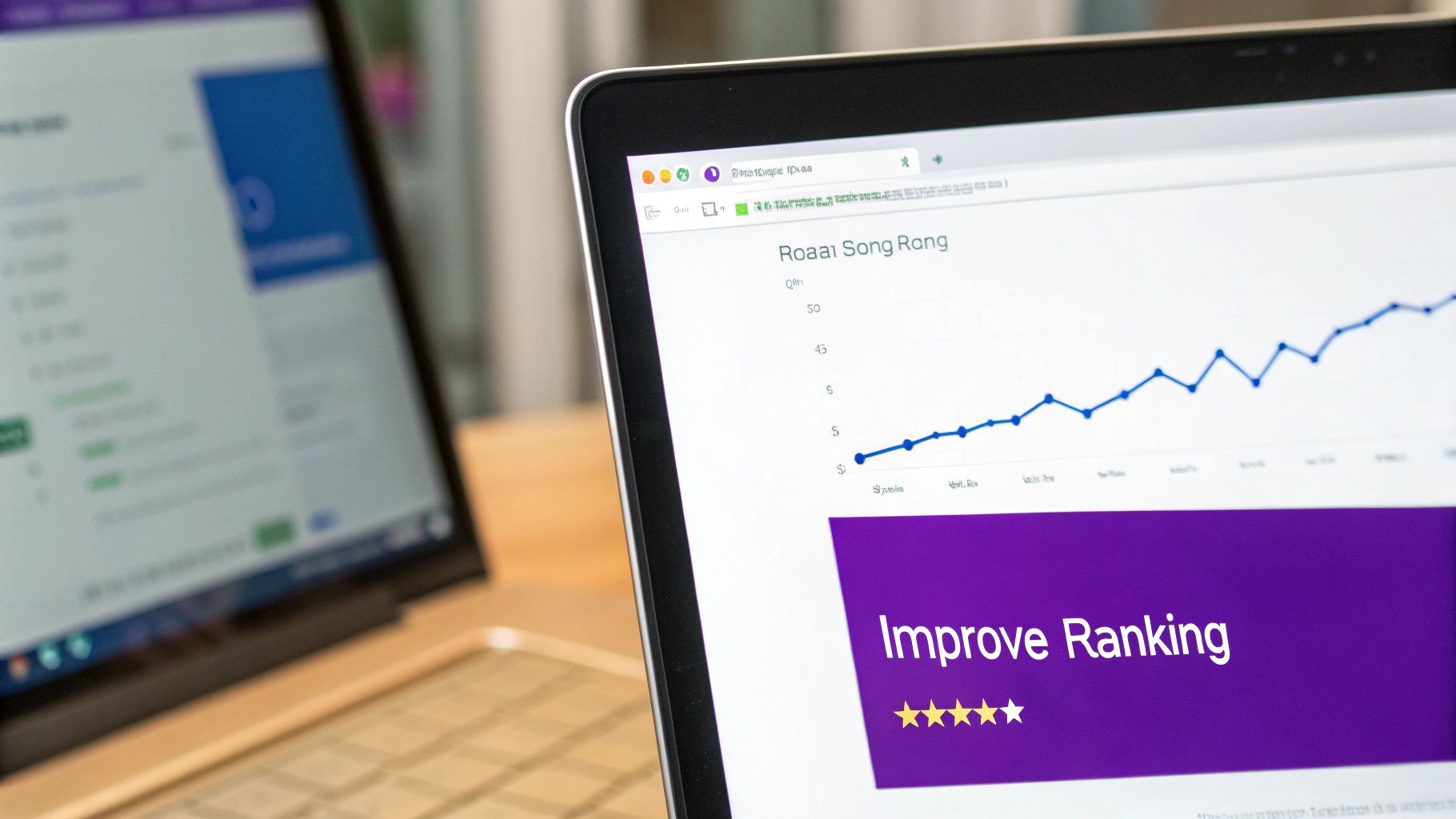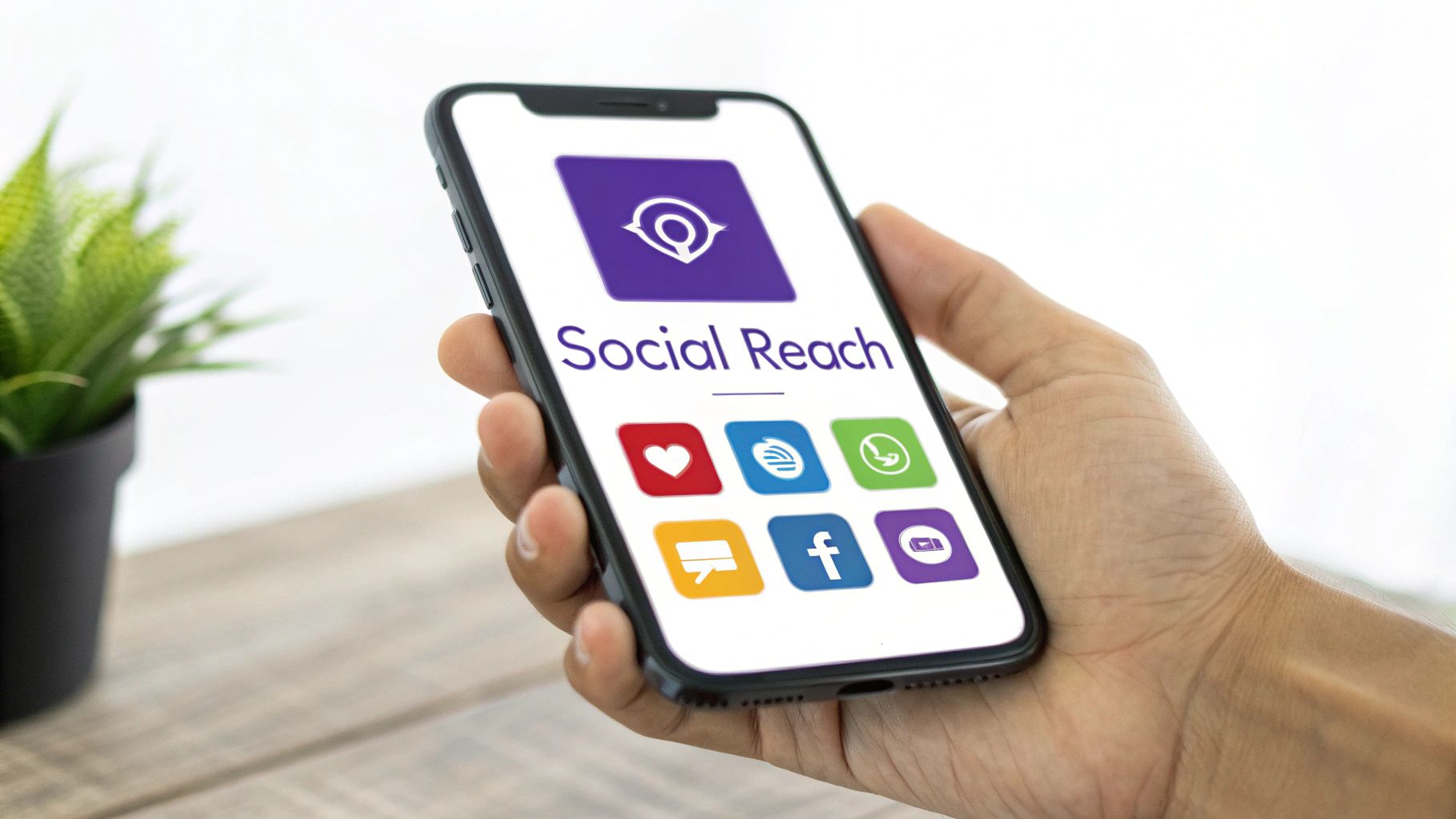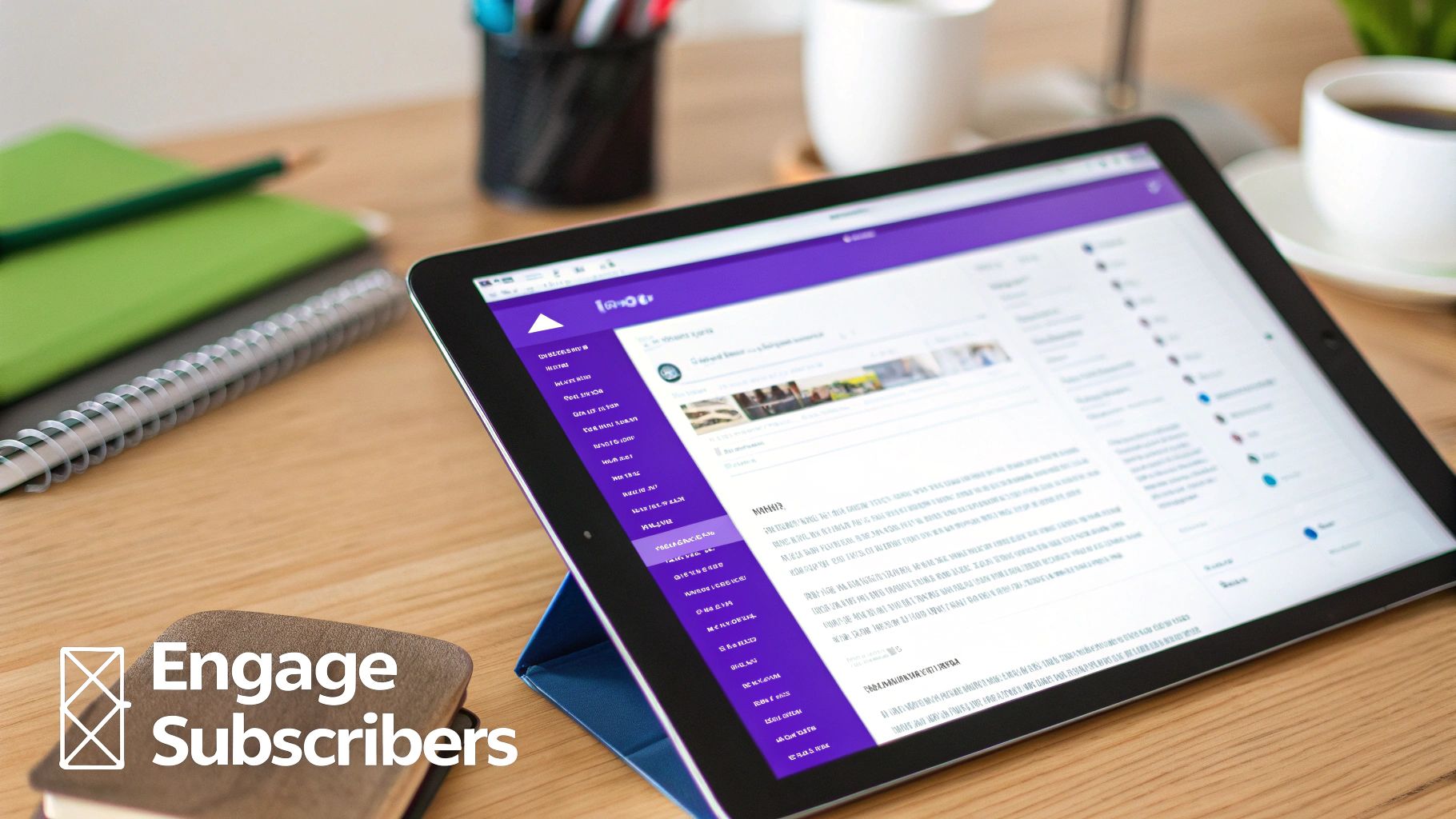9 Actionable Ways to Increase Website Traffic in 2025

Driving qualified visitors to your website is the lifeblood of modern business. More traffic means more opportunities for leads, sales, and brand growth. But with ever-changing algorithms and increasing digital noise, simply having a website is not enough. You need a multi-faceted strategy that consistently attracts the right people, turning your quiet corner of the internet into a bustling hub of activity. This is where a targeted approach to generating site visits becomes critical.
This article moves beyond generic advice to provide a deep dive into nine powerful and actionable ways to increase website traffic. We will explore a comprehensive mix of tactics, from foundational Search Engine Optimization (SEO) and content marketing to leveraging paid advertising, referral programs, and even the power of public speaking. For a comprehensive understanding of how modern technology can transform your entire marketing approach and significantly boost website traffic, consider exploring the ultimate guide to Artificial Intelligence in Marketing.
Each method we cover is broken down with practical steps, real-world examples, and expert tips designed to empower you to build a sustainable engine for growth. You won't find vague suggestions here, only concrete strategies you can implement immediately. Whether you're a demand generation manager, a SaaS founder, a sales professional, or a personal brand creator, these detailed insights will equip you to build a robust and reliable traffic-generation system. Let’s get started.
1. Search Engine Optimization (SEO)
Search Engine Optimization (SEO) is the foundational practice of enhancing your website to achieve higher rankings in search engine results pages (SERPs). It’s a powerful, long-term strategy for driving consistent, high-intent organic traffic from platforms like Google and Bing. By optimizing for specific keywords your audience uses, you position your website as the go-to answer for their queries, making it one of the most effective ways to increase website traffic sustainably.

This process involves a blend of on-page, off-page, and technical tactics. On-page SEO focuses on optimizing individual page elements like content, headers, and meta descriptions around user intent. Off-page SEO involves building authority through high-quality backlinks from other reputable websites. Technical SEO ensures your site is structured for search engine crawlers, with a focus on speed, mobile-friendliness, and site architecture. Whether you're a small business or a large enterprise, implementing effective SEO strategies for small businesses is paramount to improving your organic search visibility and attracting more visitors.
Actionable SEO Tips
To get started, focus on these core areas:
- Keyword & Intent Research: Use tools like Ahrefs or Semrush to identify keywords your target audience is searching for. More importantly, understand the intent behind the search. Are they looking to learn, compare, or buy? Tailor your content to match that intent directly.
- High-Quality Content Creation: Develop comprehensive content that thoroughly answers the user's query. Go deeper than your competitors by including unique data, expert quotes, or step-by-step instructions. For example, Backlinko’s Brian Dean popularized the "Skyscraper Technique," which involves finding top-ranking content and creating something significantly better.
- Technical Health: Your site must be fast and mobile-responsive, as these are critical ranking factors. Use Google's PageSpeed Insights to diagnose performance issues and Google Search Console to monitor for indexing errors and overall site health. A technically sound website provides a better user experience, which search engines reward.
2. Content Marketing
Content marketing is the strategic practice of creating and distributing valuable, relevant, and consistent content to attract and engage a clearly defined audience. Unlike direct advertising, this approach focuses on providing useful information that solves problems or entertains, building trust and authority. By consistently delivering value, you establish your brand as an expert resource, which naturally drives qualified visitors to your site and is one of the most sustainable ways to increase website traffic.

This strategy hinges on understanding your audience's needs and creating content that meets them where they are. It’s not just about blog posts; it encompasses videos, podcasts, case studies, white papers, and social media updates. Successful examples are everywhere: HubSpot’s marketing blog attracts millions of monthly readers by offering expert advice, while Red Bull’s extreme sports content has built a massive audience by focusing on entertainment and lifestyle. The core principle, popularized by experts like Joe Pulizzi and Ann Handley, is to shift from pitching to providing value, turning your website into a magnet for potential customers. Before you can create effective content, you need to understand exactly who you are creating it for, which you can do by creating detailed buyer personas. You can discover how to create buyer personas to better guide your content strategy.
Actionable Content Marketing Tips
To build a content engine that drives traffic, implement these tactics:
- Develop a Content Calendar: Consistency is crucial for building an audience. Plan your content topics, formats, and publishing schedule in a calendar to ensure a steady stream of valuable information. This prevents last-minute scrambling and keeps your marketing efforts on track.
- Focus on Evergreen Content: Create content that remains relevant and valuable long after its publication date. How-to guides, comprehensive resource lists, and foundational articles can attract steady traffic for years, providing a high return on your initial time investment.
- Repurpose Content for Multiple Platforms: Maximize the reach of every content piece by repurposing it into different formats. A single blog post can be transformed into an infographic, a video script, a series of social media updates, or a podcast episode, allowing you to connect with different audience segments across various channels.
3. Social Media Marketing
Social Media Marketing involves leveraging platforms like LinkedIn, X (formerly Twitter), Instagram, and TikTok to build brand awareness, engage with a community, and drive qualified traffic directly to your website. It's a dynamic strategy that combines organic content distribution with targeted paid advertising, allowing you to meet your audience where they actively spend their time. By creating and sharing valuable content, you can turn passive followers into active website visitors and potential customers, making it a critical component for increasing website traffic.

This approach is about more than just broadcasting promotional messages; it's about building relationships and fostering community. Brands like Glossier built a billion-dollar valuation primarily through authentic engagement on Instagram, while Wendy's witty X account generates millions of impressions and site visits. Success hinges on a deep understanding of each platform's unique culture and algorithm. For a comprehensive guide on building a powerful presence and driving traffic through social channels, explore this detailed social media marketing strategy playbook.
Actionable Social Media Tips
To effectively drive traffic from social media, focus on these core strategies:
- Platform-Specific Content: Don't just cross-post the same message everywhere. Tailor your content to the platform. Use professional insights and long-form text on LinkedIn, quick-hitting visuals and trending audio on Instagram Reels or TikTok, and engaging conversations on X. This shows you understand the platform's native language.
- Authentic Engagement & Community Building: Go beyond simply posting. Actively respond to comments, answer questions in DMs, and participate in relevant conversations. Share user-generated content and behind-the-scenes glimpses to humanize your brand and build a loyal community that is more likely to visit your site.
- Optimize Your Bio and Posts for Clicks: Your profile bio is prime real estate. Always include a clear call-to-action (CTA) with a link to your website, a key landing page, or a link-in-bio tool. Within your posts, explicitly tell your audience why they should click the link, whether it's to read a full article, grab a resource, or sign up for an event. Using the right social media management tools can streamline this process significantly.
4. Pay-Per-Click (PPC) Advertising
Pay-Per-Click (PPC) advertising is a powerful method for driving immediate and highly targeted visitors to your website. Unlike organic strategies that take time to build momentum, PPC allows you to place ads directly in front of potential customers on platforms like Google Ads and Microsoft Ads. Advertisers bid on specific keywords relevant to their business and pay a fee only when a user clicks their ad, offering a direct and measurable way to increase website traffic with precise budget control.

This approach provides instant visibility at the top of search results, allowing you to capture high-intent users at the exact moment they are searching for a solution you offer. Success in PPC, pioneered by experts like WordStream founder Larry Kim and author Perry Marshall, relies on a combination of strategic bidding, compelling ad copy, and optimized landing pages. For instance, Unbounce famously used its own landing page optimization techniques to achieve a 30% lower cost-per-acquisition in its campaigns. This demonstrates that PPC is not just about the ad itself, but the entire user journey that follows the click.
Actionable PPC Tips
To launch a successful PPC campaign, focus on these critical elements:
- Start with Specific Keywords: Begin with exact match and phrase match keywords to maintain tight control over your ad spend and target only the most relevant searches. This prevents your budget from being wasted on broad, low-intent queries. As you gather performance data, you can strategically expand to broader match types.
- Create Compelling, Relevant Ad Copy: Your ad copy must directly address the user's search intent and include a clear call-to-action (CTA). A/B test different headlines and descriptions to see what resonates most with your audience. The goal is to create an ad so relevant that it feels like the definitive answer to the user's query.
- Optimize Your Landing Pages: A click is only the first step. Your landing page must deliver on the promise of your ad and be designed for conversions. Ensure the page is mobile-friendly, loads quickly, and has a clear, frictionless path for the user to take the desired action, whether it's filling out a form or making a purchase.
- Utilize Negative Keywords: Actively build a list of negative keywords to exclude irrelevant searches from triggering your ads. For example, if you sell premium software, you might add "free" or "cheap" to your negative keyword list. This simple step is one of the most effective ways to improve your return on ad spend (ROAS).
5. Email Marketing
Email marketing is a direct and powerful method for driving highly engaged visitors back to your website. Instead of waiting for users to find you, this strategy involves building a list of subscribers and proactively sending them valuable content, updates, and offers. It's a key channel for nurturing relationships with your audience, turning one-time visitors into a loyal community, and is one of the most reliable ways to increase website traffic with an audience that has already expressed interest in your brand.
This approach works by establishing a direct line of communication with people who have opted in to hear from you. Unlike social media or search algorithms, you own your email list, giving you full control over your message and its delivery. Companies like TheSkimm and Morning Brew have built multi-million dollar media empires primarily on the back of a single, well-crafted daily newsletter. This demonstrates the immense power of email to not only drive traffic but also build a sustainable business model by consistently delivering value straight to the user's inbox.
Actionable Email Marketing Tips
To leverage email for traffic growth, focus on these core actions:
- Offer a Compelling Lead Magnet: Attract subscribers by offering something valuable in exchange for their email address. This could be a free ebook, a checklist, a webinar recording, or a template. The goal is to provide a high-value resource that solves a specific problem for your target audience, making the sign-up a no-brainer.
- Segment and Personalize: Don't send the same message to everyone. Segment your list based on user behavior, interests, or demographic data. Personalized emails that cater to a subscriber's specific needs have significantly higher open and click-through rates, driving more qualified traffic to relevant pages on your site.
- Craft Irresistible Subject Lines & CTAs: Your subject line is the gatekeeper to your content. Make it clear, compelling, and curiosity-driven to maximize open rates. Inside the email, every message should have a single, clear call-to-action (CTA) that tells the reader exactly what to do next, whether it’s reading a new blog post, checking out a product, or registering for an event. You can learn more about how email marketing fuels lead generation and drives targeted traffic.
6. Video Marketing
Video marketing is a dynamic strategy that leverages engaging video content to promote your brand, explain complex products, and ultimately funnel viewers back to your website. It’s one of the most powerful ways to increase website traffic because it captures attention on crowded platforms like YouTube and social media, building a human connection that text and images alone cannot. By creating valuable video content, you can establish authority, demonstrate value, and give audiences a compelling reason to visit your site.
This approach works by meeting audiences where they are already consuming content. From educational tutorials and product demonstrations to entertaining behind-the-scenes glimpses, video excels at storytelling. A classic example is Blendtec's "Will It Blend?" series, which used humor to demonstrate product power, driving massive brand awareness and sales. Similarly, Moz’s "Whiteboard Friday" series established the company as a thought leader in SEO, consistently driving high-intent traffic to its website for years. These successes show that well-executed video content does more than just entertain; it builds a loyal audience eager to learn more.
Actionable Video Marketing Tips
To effectively drive traffic with video, integrate these core practices:
- Optimize for Search & Discovery: Treat your videos like any other piece of content. Optimize titles and descriptions with relevant keywords on platforms like YouTube, which is the world's second-largest search engine. A well-optimized video can rank in both YouTube and Google search results, creating a dual source of traffic.
- Include a Clear Call-to-Action (CTA): Never assume viewers will know what to do next. Explicitly tell them to visit your website for a free template, a more detailed guide, or a special offer. Place links in the video description, pinned comments, and as on-screen end cards to make it easy for them to click through.
- Create a Consistent Content Series: Build viewer anticipation by creating a recurring series, like a weekly tutorial or a monthly Q&A session. This consistency, championed by creators like Amy Landino, encourages subscriptions and turns casual viewers into a dedicated community that reliably visits your site for new content and resources.
7. Influencer Partnerships and Collaborations
Influencer partnerships involve collaborating with individuals who have established, engaged audiences in your target market. This strategy moves beyond traditional advertising by leveraging the trust and credibility these creators have built with their followers. By working with them on sponsored content, product reviews, or co-created campaigns, you can tap into a pre-qualified audience and drive highly relevant traffic directly to your website. It’s one of the most effective ways to increase website traffic by borrowing authority and reach.
This approach is powerful because it relies on authentic storytelling. Rather than a direct brand message, your product or service is introduced through a trusted voice, making the recommendation feel more like a genuine suggestion from a friend. Brands like Daniel Wellington famously scaled to a multi-million dollar business almost entirely through influencer marketing, sending watches to micro-influencers to generate a groundswell of authentic content. Similarly, Audible’s widespread podcast sponsorships have made it a household name by tapping into the loyal listener bases of countless shows.
Actionable Influencer Marketing Tips
To execute a successful influencer campaign, focus on authenticity and clear metrics:
- Prioritize Alignment and Engagement: Look beyond follower counts. A smaller, niche influencer with high engagement rates is often more valuable than a macro-influencer with a passive audience. Use tools to analyze their audience demographics and engagement metrics to ensure their values and followers align perfectly with your brand.
- Grant Creative Freedom: The most effective influencer content feels native to their channel, not like a scripted ad. Provide clear brand guidelines and campaign goals, but give the creator the freedom to present your product in their unique voice. This authenticity is what resonates with their audience and drives action.
- Track ROI with Unique Codes and Links: To measure success and justify the investment, provide each influencer with a unique UTM-tagged link or a custom discount code. This allows you to precisely track how much traffic, and how many conversions, each collaboration generates, enabling you to optimize future campaigns.
8. Guest Posting and Content Syndication
Guest posting and content syndication are powerful outbound strategies for tapping into established audiences and building brand authority. Guest posting involves writing and publishing an article on another website in your niche, while content syndication is the practice of republishing your existing content on third-party platforms. Both methods are proven ways to increase website traffic by placing your expertise in front of new, relevant readers and generating valuable backlinks that boost your domain authority.
This two-pronged approach allows you to leverage the credibility of other respected publications. By contributing high-value content, you not only drive direct referral traffic but also signal to search engines that your site is a reputable source of information. Pioneers like Brian Dean of Backlinko and Neil Patel built their entire brands on the back of prolific, strategic guest posting, demonstrating how this tactic can accelerate growth from the ground up. This method is especially effective for building brand recognition and establishing yourself as a thought leader in a competitive market.
Actionable Guest Posting & Syndication Tips
To maximize your results, approach this with a clear strategy:
- Strategic & Personalized Pitching: Identify websites where your target audience already congregates. Before pitching, study their content style, tone, and audience needs. Craft a personalized pitch that offers a unique, data-driven article idea that fills a gap in their existing content, rather than sending a generic template. Building a relationship with the editor beforehand can significantly increase your acceptance rate.
- Create Bespoke, High-Value Content: Once your pitch is accepted, write the best piece of content you possibly can, tailored specifically for that publication's audience. Don't just rehash old ideas. Instead, provide fresh insights, actionable steps, and unique data. The goal is to impress the new audience so much that they are compelled to click through to your website to learn more about you.
- Syndicate with a Canonical Tag: When republishing content, ensure the syndicating site uses a canonical tag (
rel="canonical") pointing back to the original article on your website. This tells search engines like Google that your page is the primary source, preventing duplicate content issues and consolidating all SEO value, like link equity, to your original post.
9. Referral Programs and Word-of-Mouth Marketing
Referral programs are a powerful strategy for leveraging your existing customer base to generate new, high-quality traffic. By incentivizing satisfied users to share your website or product with their networks, you tap into the unparalleled power of word-of-mouth recommendations. This approach turns your loyal customers into a dedicated marketing channel, driving visitors who arrive with a built-in layer of trust. It’s a highly effective way to increase website traffic because a recommendation from a friend is often more persuasive than any advertisement.
This method transforms organic satisfaction into a structured growth engine. Instead of just hoping customers will talk about you, a referral program provides a clear, rewarding mechanism for them to do so. Iconic examples include Dropbox, which achieved explosive growth by offering extra storage space for both the referrer and the new user, and Airbnb, which used travel credits to fuel its global expansion. These programs succeed by making the act of sharing both easy and mutually beneficial, creating a viral loop that continually brings in new, engaged visitors.
Actionable Referral Program Tips
To build a program that drives consistent traffic, focus on these key elements:
- Offer Dual-Sided, Valuable Incentives: The most successful programs reward both the person referring and the person being referred. This creates a win-win scenario that encourages participation. The reward must be valuable enough to motivate action, whether it's a discount, store credit, a free feature, or exclusive content.
- Make Sharing Effortless: The referral process must be incredibly simple. Provide users with a unique, easy-to-copy link or pre-written messages for social media, email, and messaging apps. Integrate the referral option into key touchpoints like the user dashboard, post-purchase confirmation pages, and email newsletters. The fewer clicks required, the higher your conversion rate will be.
- Promote and Track Your Program: Don't just build a referral program and hope users find it. Actively promote it across all your marketing channels. Use analytics to track which customers are your best advocates, which channels drive the most referrals, and what your overall conversion rate is. This data is critical for optimizing your incentives and promotional efforts over time.
9 Methods to Boost Website Traffic Comparison
Here's a breakdown of each strategy, comparing their complexity, resource needs, and ideal outcomes.
1. Search Engine Optimization (SEO)
- Complexity: Medium to High
- Resources: Moderate (keyword tools, content, tech)
- Outcomes: Long-term organic traffic growth
- Use Cases: Increasing organic search visibility
- Advantages: Sustainable growth, cost-effective
2. Content Marketing
- Complexity: Medium
- Resources: Moderate to High (content creation)
- Outcomes: Long-term brand authority & traffic
- Use Cases: Audience education, brand building
- Advantages: Builds authority, supports SEO
3. Social Media Marketing
- Complexity: Medium to High
- Resources: Moderate (content, management tools)
- Outcomes: Real-time engagement, viral growth
- Use Cases: Brand awareness, direct audience engagement
- Advantages: Direct engagement, viral potential
4. Pay-Per-Click (PPC) Advertising
- Complexity: Medium
- Resources: Variable (ad spend, management tools)
- Outcomes: Immediate traffic and leads
- Use Cases: Quick traffic, targeted campaigns
- Advantages: Immediate results, precise targeting
5. Email Marketing
- Complexity: Medium
- Resources: Moderate (list management, tools)
- Outcomes: High ROI, audience retention
- Use Cases: Nurturing leads, direct communication
- Advantages: High ROI, automation capabilities
6. Video Marketing
- Complexity: High
- Resources: High (production, editing)
- Outcomes: High engagement, conversion boost
- Use Cases: Visual storytelling, product demos
- Advantages: High engagement, viral potential
7. Influencer Partnerships
- Complexity: Medium
- Resources: Moderate to High (collaborations)
- Outcomes: Access to engaged audiences
- Use Cases: Brand credibility, expanding reach
- Advantages: Authentic reach, cost-effective
8. Guest Posting & Content Syndication
- Complexity: Medium
- Resources: Moderate (content creation, outreach)
- Outcomes: Authority building, SEO backlinks
- Use Cases: Thought leadership, backlink acquisition
- Advantages: Builds authority, cost-effective
9. Referral & Word-of-Mouth Marketing
- Complexity: Medium
- Resources: Moderate (program setup and management)
- Outcomes: Increased customer acquisition
- Use Cases: Customer growth, loyalty programs
- Advantages: High conversion, scalable growth
From Traffic to Transformation: Putting Your Plan into Action
Navigating the diverse landscape of digital marketing to find effective ways to increase website traffic can feel overwhelming. We have journeyed through a comprehensive toolkit, from the foundational pillars of Search Engine Optimization and Content Marketing to the dynamic, relationship-driven strategies of Influencer Partnerships and Referral Programs. Each of the nine methods detailed in this article, whether organic, paid, or community-focused, represents a powerful lever you can pull to drive meaningful growth. The challenge, however, is not simply knowing these tactics exist; it's about orchestrating them into a cohesive, sustainable strategy that resonates with your unique audience and aligns with your business objectives.
The path to a high-traffic website is not a linear sprint but a continuous cycle of strategic implementation, rigorous analysis, and intelligent adaptation. It’s a marathon built on consistent effort. Trying to master all nine approaches at once is a recipe for burnout and diluted results. Instead, the most successful marketers build momentum by focusing their efforts and stacking their wins over time.
Your Strategic Starting Point
To begin transforming this knowledge into action, avoid the temptation to do everything. Instead, adopt a focused, phased approach:
Audit and Identify: Start with an honest assessment of your current resources, skills, and audience behavior. Where are your biggest opportunities? If you have a strong existing email list, doubling down on sophisticated email marketing funnels might be your quickest win. If your product is highly visual, investing heavily in Video Marketing on platforms like YouTube or TikTok could yield the highest return.
Select and Master: Choose one or two strategies that align perfectly with your audit's findings. If you choose Content Marketing and SEO, dedicate your energy to mastering them. This means creating a content calendar, learning the nuances of keyword research, building a backlink outreach process, and tracking your rankings. Go deep, not wide.
Integrate and Amplify: Once you have built a reliable engine with your initial strategies, begin layering in complementary tactics. For example, your successful content marketing efforts can be amplified through targeted PPC ads to reach a wider audience. The valuable video content you create can be repurposed into blog posts, social media clips, and email newsletters, creating a powerful synergy that makes each component work harder.
The ultimate goal is to move beyond simply accumulating clicks. True transformation happens when you see website traffic not as the finish line, but as the starting point for a valuable customer relationship. Each visitor represents a potential conversation, a future brand advocate, or your next loyal customer. The critical question then becomes: how do you effectively capture that initial interest and convert it into a tangible connection?
For the many professionals who leverage public speaking, workshops, and webinars as a core part of their growth strategy, this is a particularly acute challenge. You capture an audience's full attention for 30 or 60 minutes, but how do you translate that engagement into direct, trackable website traffic and qualified leads? This is precisely where a dedicated tool becomes not just a nice-to-have, but a strategic necessity.
By integrating a platform designed for speaker-led lead generation, you can seamlessly bridge the gap between your offline or virtual stage and your online marketing funnel. A simple, scannable QR code on a presentation slide can instantly direct an engaged audience to a purpose-built landing page. This turns a fleeting moment of high intent into a measurable action, directly fueling your website with warm leads who are already primed by your message. This method transforms your speaking engagements from brand-building exercises into powerful, quantifiable traffic-driving events, proving the ROI of your efforts and building a robust growth engine.
Ready to turn your speaking engagements into a predictable source of high-quality website traffic? SpeakerStacks makes it simple to capture leads directly from your presentations with custom landing pages and QR codes. Stop letting audience engagement fade away and start building your pipeline by visiting SpeakerStacks to see how you can transform your next talk into a traffic-generating machine.